Wasps
This page is intended as a summary of the wasps found in the Recording Area. It is in the main a photographic guide to what can be seen and identified on site. The species included in this summary are those that are common on site (unless otherwise stated) and can usually be identified in the field or by close up digital photographs. Therefore, it is largely confined to social wasps, digger wasps, potter wasps, gall wasps, spider-hunting wasps and the more readily identified ichneumon and cuckoo wasps.
Wasps represent by far
the largest suborder of insects in Britain with over 6,600 species. The vast
majority of these require microscopic examination to aid identification
especially ichneumon and braconid wasps, even then identification to species
level can be very difficult.
In total 182 species have recorded on the Warren, many of these have been
recorded by visiting entomologists, most of whom collected specimens for
identification. Unfortunately permission has not been granted to the
Dawlish Warren Recording Group, therefore in recent years the vast majority
of identifications have been made by in-the-field sightings.
Summary and photos by Recording Group member Alan Keatley.
Related links: Bees, Wasps & Ants Recording Society Steven Falk Flickr collection
Last update 30/08/2022.
Species
Ichneumonidae
(Darwin wasps).
Small to very large. Parasitoids with very
long antennae.
Umbellifer Darwin Wasp (Amblyteles armatorius).
Woodland clearings and bramble patches.
Orange-legged Darwin Wasp (Pimpla rufipes).
Straight ovipositor. Vegetated areas, mainly in late Summer and Autumn.
Apechthis compunctor. Downward pointing
ovipositor. Bushes and meadows.
Callajoppa cirrogaster. Largest ichneumon.
Parasitoid of hawkmoth caterpillars. One record July 2020.
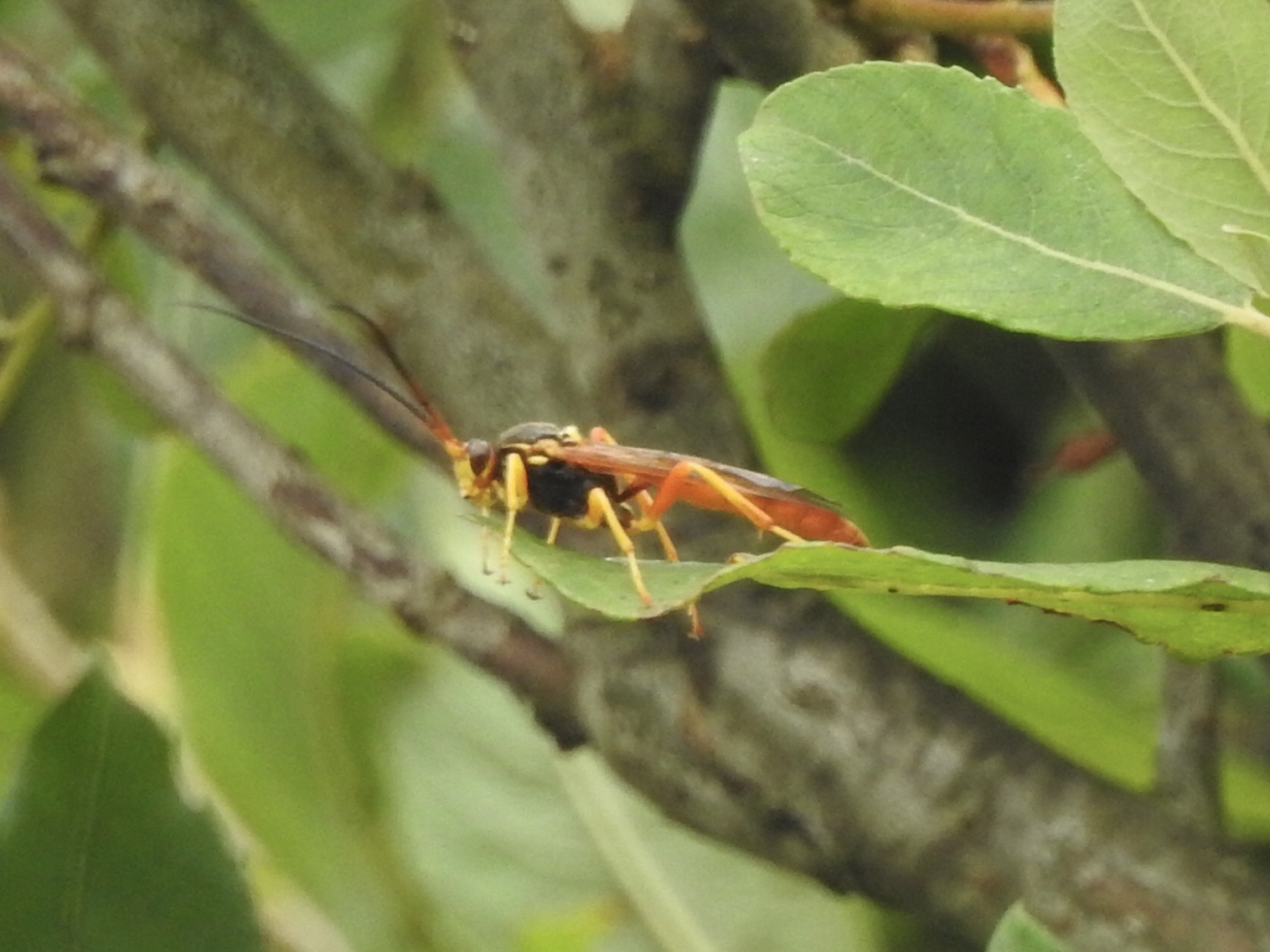
Gasteruptiidae
(Javelin wasps). Females have a very long
ovipositor.
Gasteruption jaculator. Meadows on umbellifers.
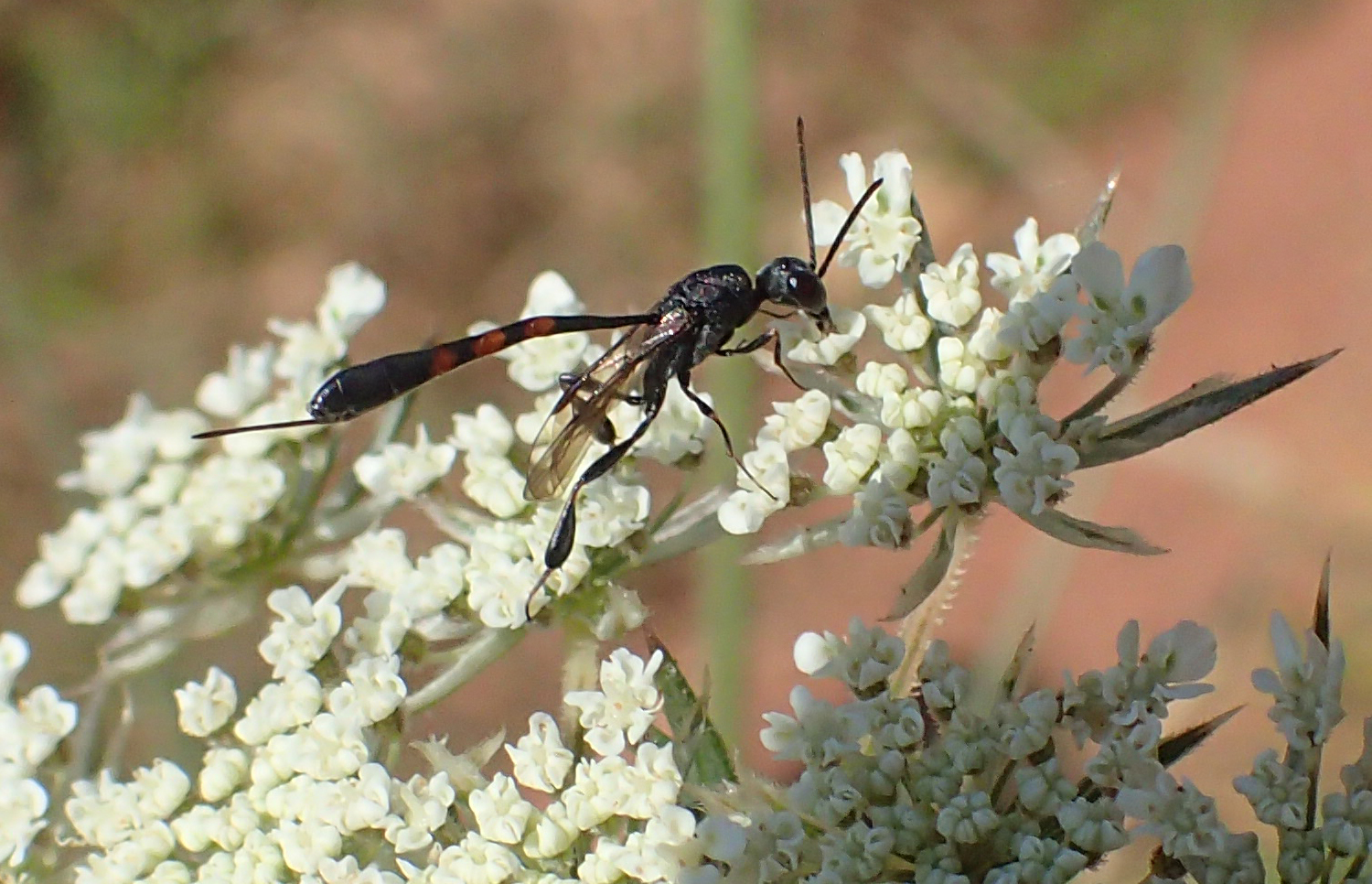
Chrysididae
(Cuckoo wasps).
Small to medium sized. Metallic looking and colourful. Parasitoid of digger
and mason wasps.
Golden Cuckoo Wasp (Pseudomalus auratus).
Nest in bramble and other woody stems. Seen on fence posts and on
vegetation.
Violet Cuckoo Wasp (Pseudomalus violaceus).
Nationally scarce. One record prior to 1969. Present status on site unknown.
Woodland edges.
Dull Cuckoo Wasp (Hedychridium roseum).
Local on sand dunes and heaths.
Glowing Cuckoo Wasp (Hedychridium ardens).
Open sandy areas.
Impressive Cuckoo Wasp (Chrysis impressa).
Woodland edges.
Linnaeus's Cuckoo Wasp (Chrysis ignita).
Woodland edges, walls and fence posts.
Mutillidae
(Velvet ants). Not an ant, but an
ant-like wasp.
Least Velvet Ant (Myrmosa atra). Males can
be found on flowers, wingless females in sandy areas searching for digger
wasp nests. No recent records.
Sapygidae
(Club-horned
wasps)
Five-spotted Club-horned Wasp (Sapyga
quinquepunctata). Parasitoid of red mason bees. First record June 2018.
Pompilidae
(Spider-hunting
wasps)
Leaden Spider Wasp (Pompilus cinereus).
Numerous in bare sand areas hunting ground spiders.
Variable Spider Wasp (Dipogon variegatus).
only hunts the common crab spider Xysticus cristatus. Double-banded
fore-wings. First record August 2021.
Red-legged Spider Wasp (Episyron rufipes).
Can be found nectaring on umbellifers. Hunts orb web spiders.
Anoplius infuscatus. Males can be found on
umbellifers, females hunting wolf spiders on bare sandy ground.
Sphecidae
(Sand wasps)
Red-banded Sand Wasp (Ammophila sabulosa).
Frequently found in bare sandy areas hunting caterpillars. The only insect
on the SSSI citation.
Vespidae
(Social, potter and mason wasps). Medium to large. Nest building wasps.
Red Wasp (Vespula rufa). Scrubby grass areas,
nests underground. Few records.
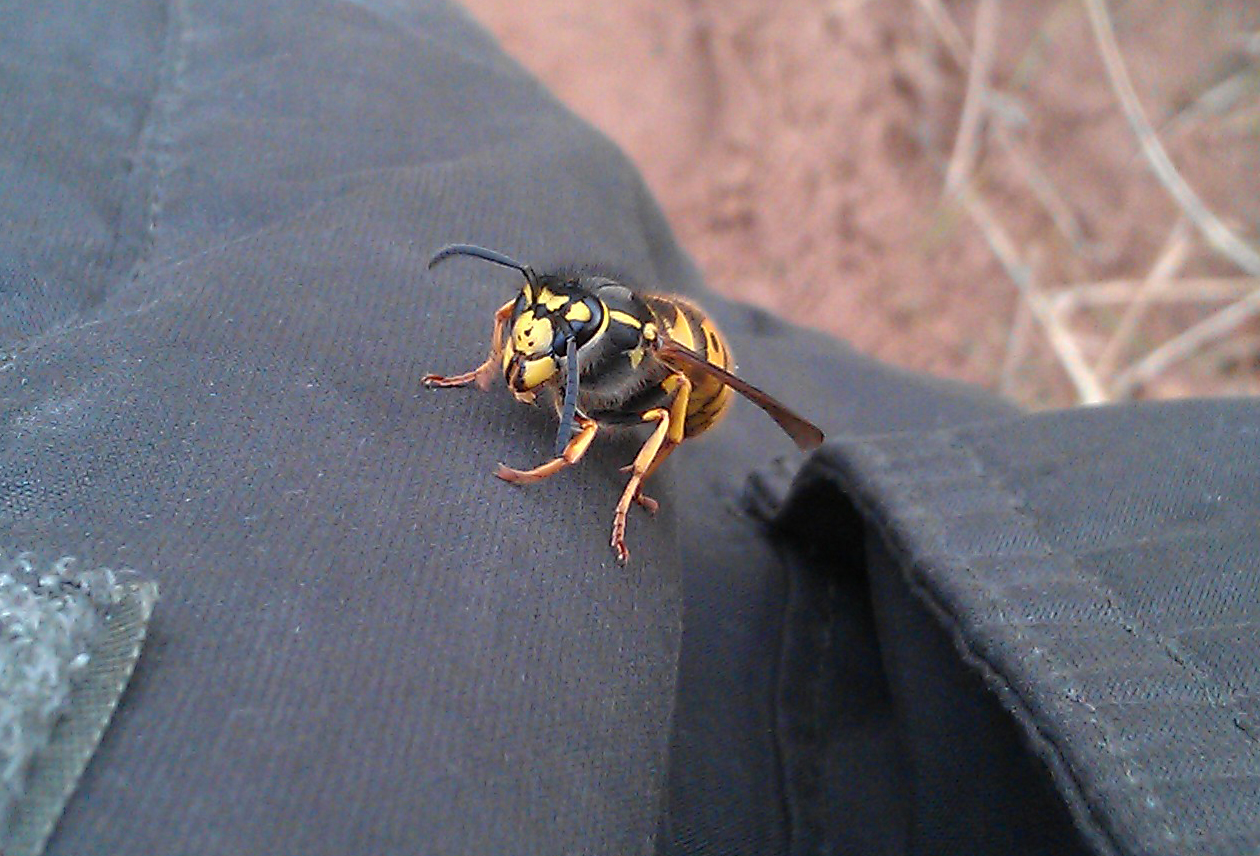
Common Wasp (Vespula vugaris). Commonest social
wasp with several nests.
German Wasp (Vespula germanica). Less numerous
than Common Wasp.
Hornet (Vespa crabro). One or two records per
annum, usually in autumn.
Tree Wasp (Dolichovespula sylvestris). Nest in
trees. Few records, no nests yet found.
Norwegian Wasp (Dolichovespula norwegica).
Nationally local species, nests in shrubs and trees. Few records. No nests
found.
Median Wasp (Dolichovespula media). Nationally
scarce, first recorded in Britain in 1980, rapidly increasing and expanding
range. First site record April 2019.
Heath Potter Wasp (Eumerus coarctatus).
Nationally scarce. One record August 2018, totally unexpected as usual
habitat is heathland with areas of clay soil.
Small-notched Mason Wasp (Ancistrocerus gazella).
Mason wasp species differ in width and shape of first abdominal band.
Frequent flower visitor.
Maritime Mason Wasp (Ancistrocerus scoticus).
Nationally local coastal species. No recent records.
Three-banded Mason Wasp (Ancistrocerus triasciatus).
Parasitised by Linnaeus's Cuckoo Wasp (Chrysis ignita).
Willow Mason Wasp (Symmorphus bifasciatus).
Frequently seen on umbellifers in woodland.
Little Mason Wasp (Mircodynerus exilis).
Nationally scarce. Hunts weevils.
Crabronidae
(Digger wasps). Small to large solitary wasps. Nest location and prey type
can help with identification. Many species are flower visitors, but not all.
Peak appearance June to August.
Minute Black Wasp (Diodontus minutus). Small,
all black except for reddish legs. Nests in sandy areas provisioned with
winged aphids.
Melancholy Black Wasp (Diodontus tristis).
Very similar to above, with black legs. Nests in sandy areas provisioned
with wingless aphids. Last recorded in
August 1981.
Mournful Wasp (Pemphredon lugubris). All
black wasp, appears from beginning of May, earlier than most other black
digger wasps. Stigma and joining wing
veins help identification. Nests in
dead wood provisioned with aphids.
Large-headed Crossocerus (Crossocerus
megacephalus). Small to medium, large headed wasps. All black, nests in
old beetle tunnels in dead wood
provisioned with small flies.
Tri-lobed Boxhead Wasp (Crossocerus podagrica).
All black with yellow legs. Frequent flower visitor. Nests in dead wood,
females capture small flies.
Four-spotted Digger Wasp (Crossocerus
quadrimaculatus). Prominent yellow markings on abdomen, some have
reduced markings. Often basking on leaves.
Long flight season
from early May to mid-Oct. Ground nester in sandy soils including footpaths
and rabbit burrow entrances. Prey is mainly small flies.
Wesmael's Digger Wasp (Crossocerus wesmaeli).
Black with yellow legs. Nest in sandy banks, mainly collects small flies.
Not a flower visitor.
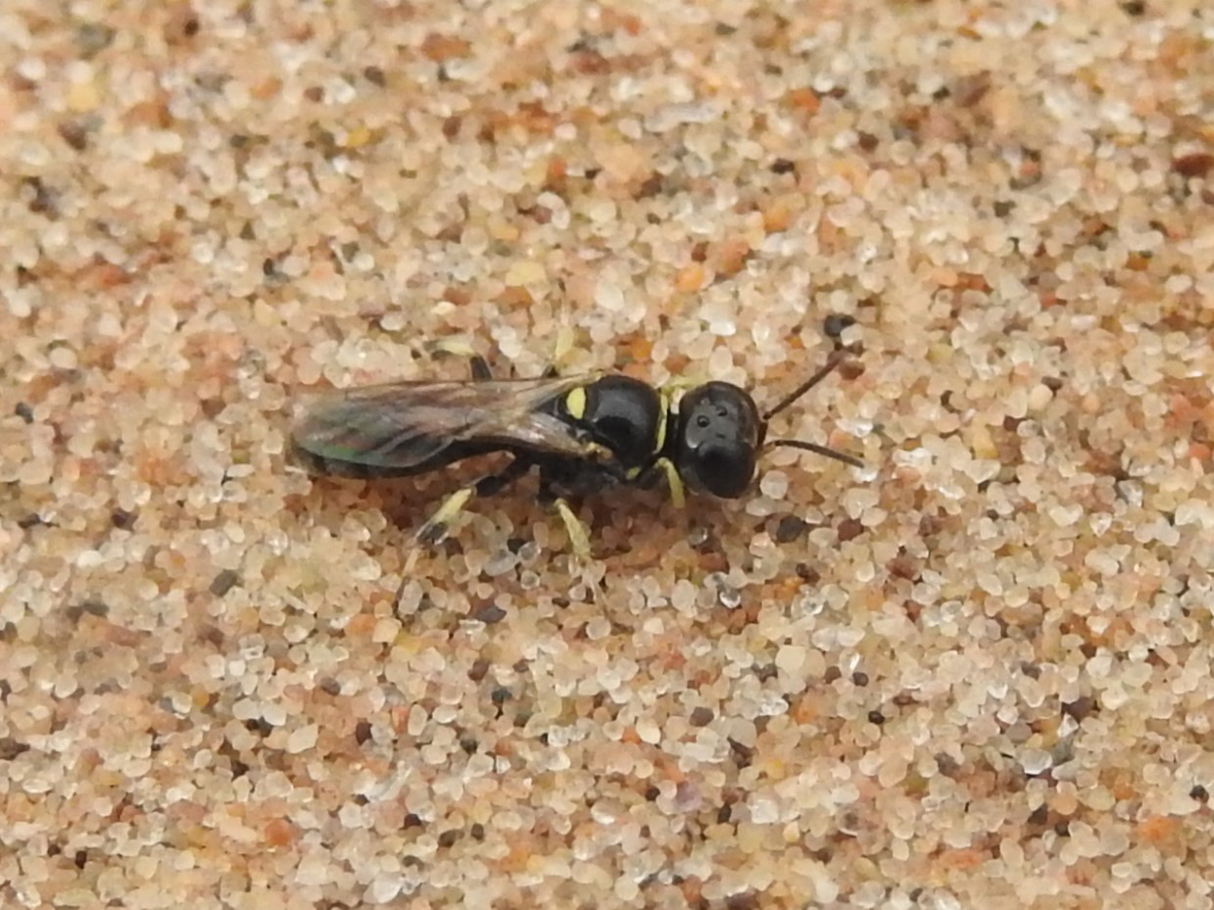
Club-horned Woodborer Wasp (Tryoxylon clavicerum).
Very elongated. Nests in stems, provisioned with spiders. No recent records.
Red-bodied Stem Wasp (Rhopalum claviers).
Elongated. Black with red abdomen. Nests in stems provisioned with barklice.
First recorded August 2021.
Shieldbug Digger Wasp (Astata boops). Black and
red. Large head and eyes. Nest provisioned with shieldbug nymphs.
Parasitised by Dull Cuckoo Wasp
Hedychridium roseum.
Dryudella pinguis. Black and red with white
head spots. Nests on bare sand, provisioned with bug nymphs.
White-spotted Digger Wasp (Harpactus tumidis).
Nests in sandy soils, collects frog hoppers from vegetation to provision
nest. No recent records.
Common Spiny Digger Wasp (Oxybelus uniglumis).
Black with white spots. Nests in sandy soils, eg golf course bunkers.
Provisions nest with flies.
Field Digger Wasp (Mellinus arvensis). Flies late Summer / Autumn. Nests in sandy soils. Preys on flies including hoverflies.
Sand-tailed Digger Wasp (Cerceris arenaria).
Active late June to late August. Ground nester, nest stocked with weevils.
Ornate-tailed Digger Wasp (Cerceris rybyensis).
Commonest Cerceris, preys on small bees. A ground nester in various
compacted soil. Visits a range of
flowers.
Slender-bodied Digger Wasp (Crabro cribrarius).
Large, robust wasp. Frequent flower visitor. Males have brown fore tibia
shield. Ground nester, preys on flies.
Armed Digger Wasp (Crabro peltarius). Very
similar to Slender-bodied Digger Wasp, but males have blue not brown fore
tibia shield. Also, a frequent flower
visitor and preys on flies.
Two-girdled Digger Wasp (Agrogorytes mystaceus).
Mainly a Spring species with a preference for open woodland habitat. Nests
on dry banks, prey is
froghoppers. No recent records.
Garden Ectemnius (Ectemnius cavifrons). A large
Ectemnius species. Identified by ridges on antennae. Nests in holes in
decaying wood, preys on hoverflies.
Large Ectemnius (Ectemnius cephalotes). A large
species found in various habitats with dead wood to nest. Frequent flower
visitor especially umbellifers.
Preys on flies including hoverflies.
Common Ectemnius (Ectemnius continuus).
Commonest Ectemnius in various habitats with dead wood and umbellifers.
Preys on flies, mainly hoverflies and
Muscidae.
Three-spotted Digger Wasp (Nysson trimaculatus).
Nationally scarce. A parasitoid of Four-banded Digger Wasp (Gorytes
quadrifasciatus) and Dark-winged
Digger Wasp (Lestiphorus bicinctus). Relying entirely
on its hosts. Records are mainly historical with a more recent record in
August 2021.
Four-banded Digger Wasp (Gorytes quadrifasciatus).
A widespread species, much commoner than its parasitoid. Frequently found
nectaring on umbellifers.
Nests in sandy soil and preys on planthoppers.
Dark-winged Digger Wasp (Lestiphorus bicinctus).
Nationally scarce. Found in scrubby areas with bramble. Nesting biology
poorly known, preys on various
bugs. Host of Three-spotted Digger Wasp (Nysson
trimaculatus).
Bee-wolf (Philanthus triangulum). Previously
considered a rarity, this impressive digger wasp has increased in numbers
and extended its range over the last 20
years. Flies from July to September nectaring on various
flowers. Preys almost exclusively on honey bees. Nests in flat and vertical
sandy surfaces.
Cynipidae
(Gall wasps). Small wasps that induce galls on plants for larvae
development, some species only use ready formed galls to lay eggs
(inquilines). Galls are also used by parasitic wasps of the family
Chalcididae and Torymidae. Adult wasps are very difficult to identify and
therefore, galls are used in most instances to indicate their presence.
Oak Ram's-horn Gall Wasp (Andricus aries). Galls
develop on Pendunculate Oak buds. First discovered in Britain in 1997, has spread
throughout England.
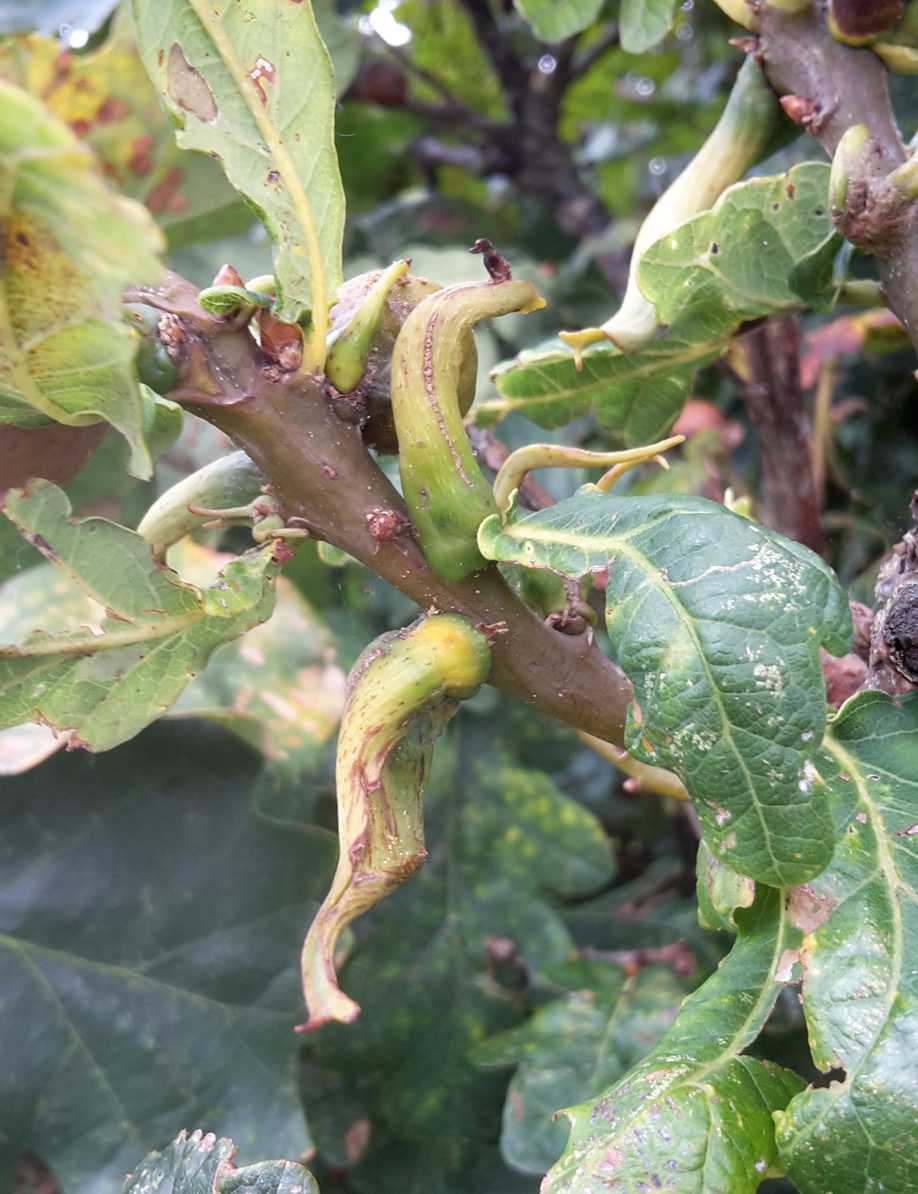
Artichoke Gall Wasp (Andricus foecundatrix).
Gall develops from an oak bud.
%20010421.jpg)
Marble Gall Wasp (Andricus kollari). Galls
develop singularly or in clusters on Turkey Oak buds, turning from green to
brown.
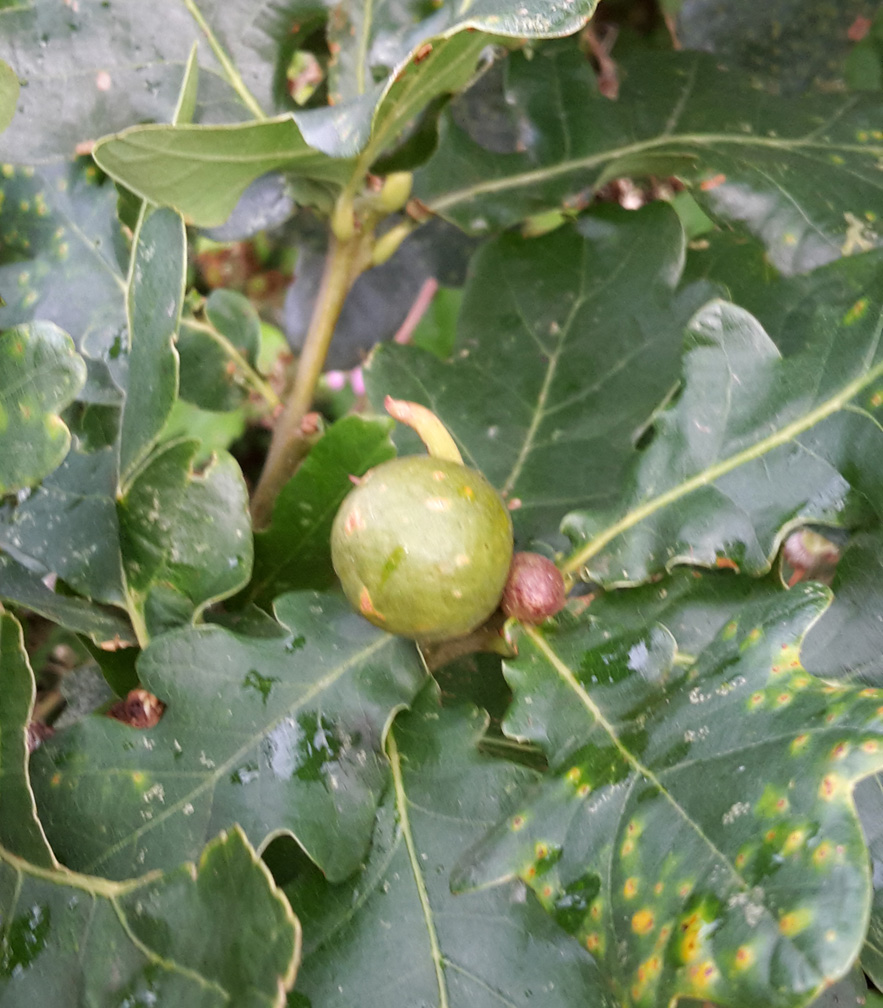
Knopper Gall Wasp (Andricus queruscalicis).
Develops on acorns. Can be abundant in some years. It arrived in Britain in
the 1960s.
Acorn Cup Gall (Andricus grossulariae). Asexual generation
develops on acorns. First recorded in the UK in 2000 and spreading rapidly.
Oak Apple Gall Wasp (Biorhiza pallida).
Develops from oak buds in late Spring.
Striped Pea Gall Wasp (Cynips longiventris).
Develops on oak leaves in mid-Summer.
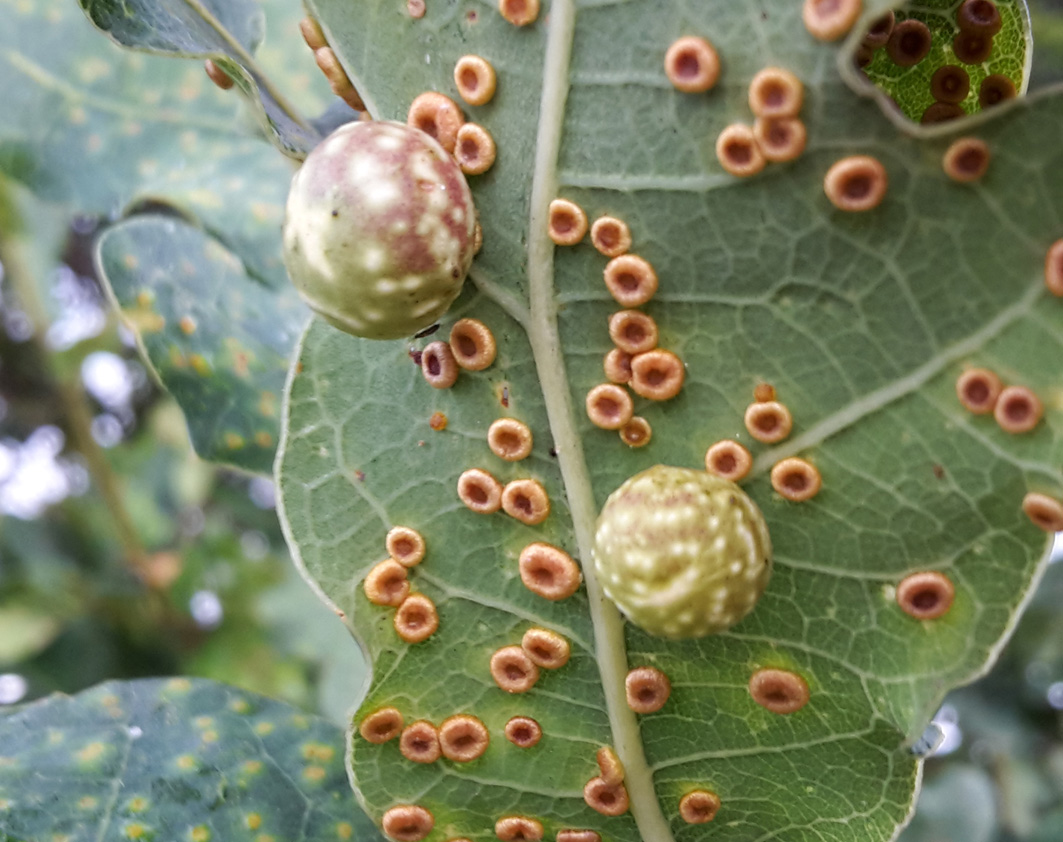
Bramble Stem Gall Wasp (Diastrophus rubi). The
gall wasp attacks fresh green bramble stems in Spring.
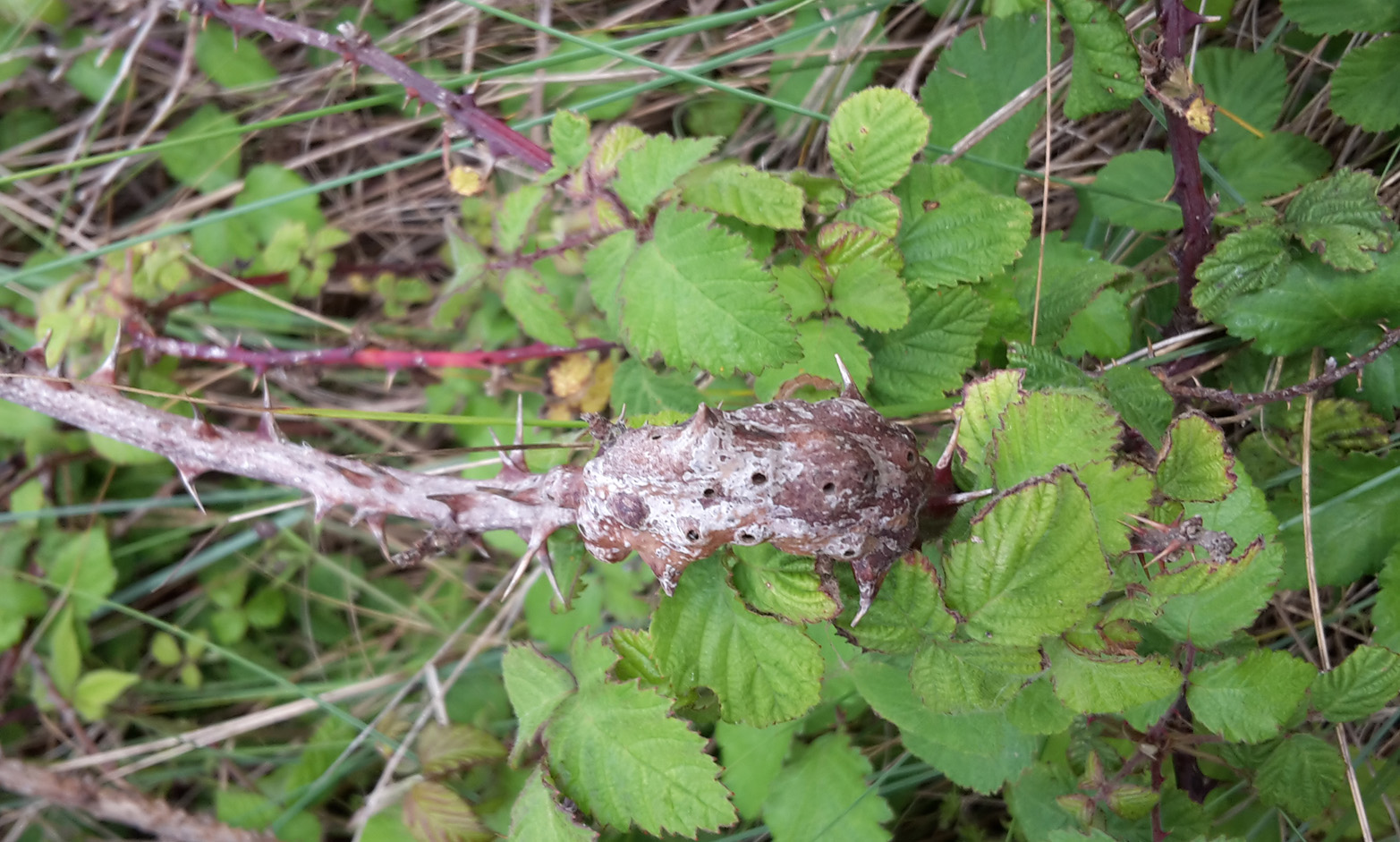
Dog Rose Gall Wasp (Diplolepis nervosa). The
gall wasp introduces two kinds of galls, a pea and a 'sputnik', on wild
roses, usually on underside of leaves, but
sometimes on upper surface. The 'sputnik' galls are formed by
this species. the pea galls below are formed either by this species or
Diplolepis eglanteriae.
Bedeguar Gall Wasp (Diplolepis rosae). Also
known as Robin's Pincushion gall. The gall wasp lays its eggs in the rosebud
in Spring, growing from stem can
reach 7 cm across. Galls can contain many egg chambers,
tenants and parasitoids.
Oyster Gall Wasp (Neuroterus anthracinus).
Egg shaped galls develop on lower sides of the veins of oak leaves.
Silk Button Gall Wasp (Neuroterus
numismalis). Develops on underside of oak leaves, often abundant in late
Summer, hundreds may occur on a
single leaf.
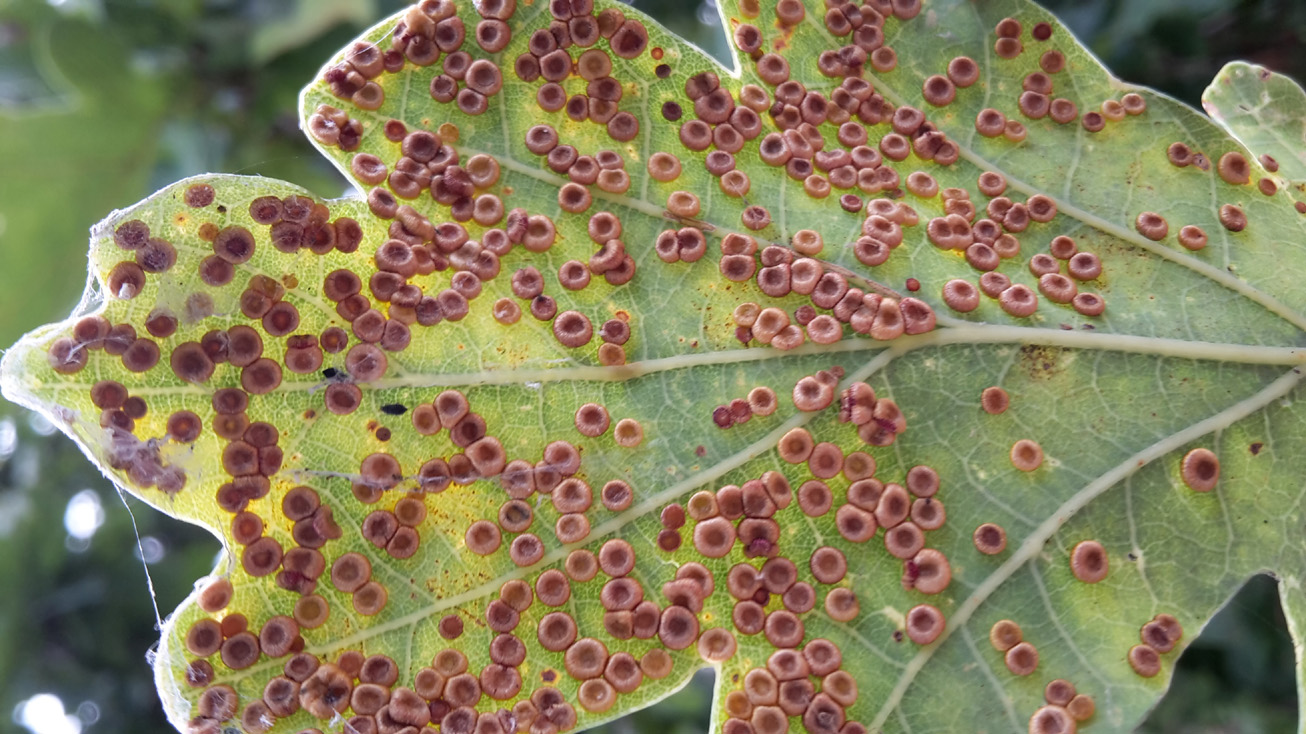
Oak Spangle Gall Wasp (Neuroterus quercusbaccarum).
A single oak leaf can contain scores of galls on the underside of the leaf.
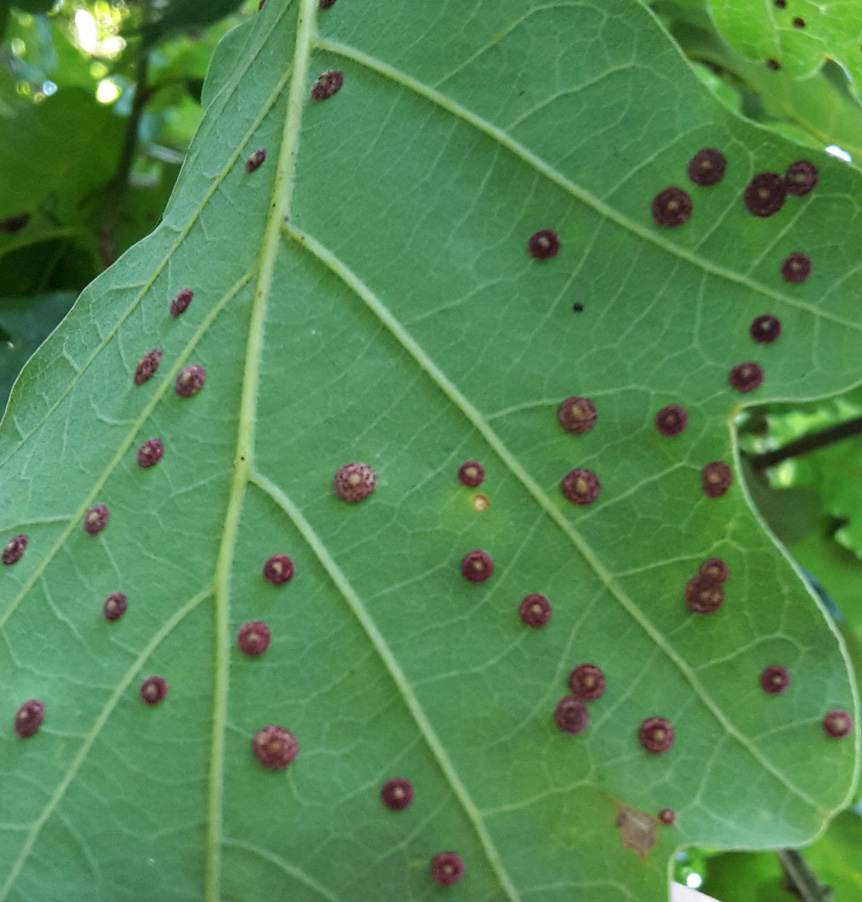
Oak Pasty Gall Wasp (Neuroterus saliens).
Develops on the mid ribs or the petioles of Turkey Oak leaves.
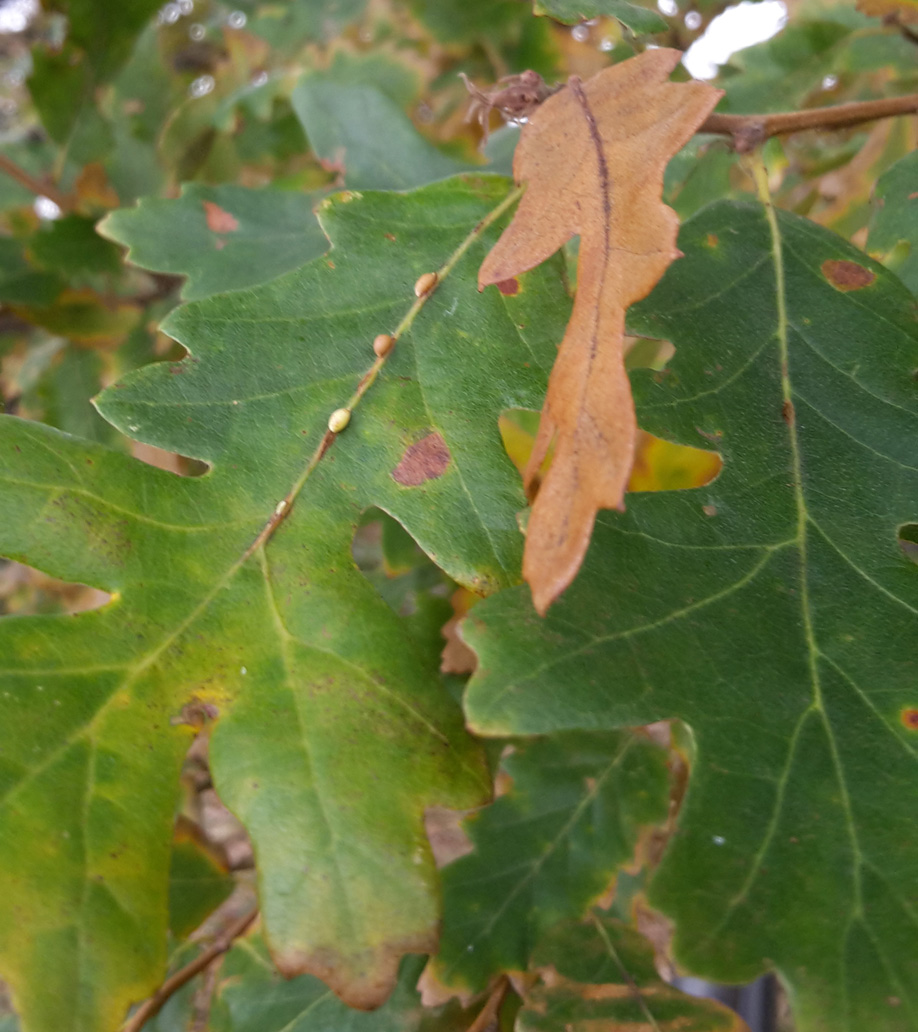
Cat's-ear Stem Gall Wasp (Phanacis hypochoeridis).
Ribbed swellings in the stems and flower stalks of cat's-ear. Develops from
mid-Summer onwards. This
gall is very local and rarely common.